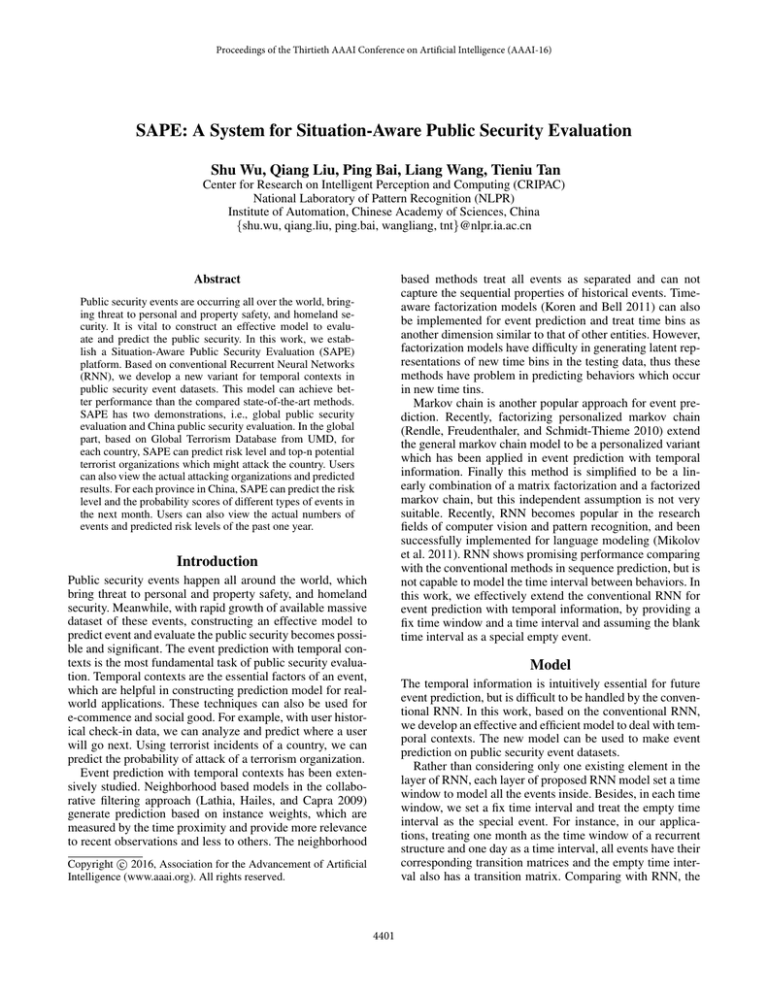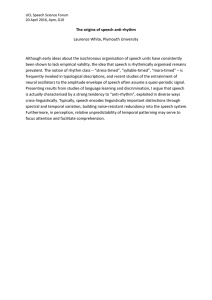
Proceedings of the Thirtieth AAAI Conference on Artificial Intelligence (AAAI-16)
SAPE: A System for Situation-Aware Public Security Evaluation
Shu Wu, Qiang Liu, Ping Bai, Liang Wang, Tieniu Tan
Center for Research on Intelligent Perception and Computing (CRIPAC)
National Laboratory of Pattern Recognition (NLPR)
Institute of Automation, Chinese Academy of Sciences, China
{shu.wu, qiang.liu, ping.bai, wangliang, tnt}@nlpr.ia.ac.cn
based methods treat all events as separated and can not
capture the sequential properties of historical events. Timeaware factorization models (Koren and Bell 2011) can also
be implemented for event prediction and treat time bins as
another dimension similar to that of other entities. However,
factorization models have difficulty in generating latent representations of new time bins in the testing data, thus these
methods have problem in predicting behaviors which occur
in new time tins.
Markov chain is another popular approach for event prediction. Recently, factorizing personalized markov chain
(Rendle, Freudenthaler, and Schmidt-Thieme 2010) extend
the general markov chain model to be a personalized variant
which has been applied in event prediction with temporal
information. Finally this method is simplified to be a linearly combination of a matrix factorization and a factorized
markov chain, but this independent assumption is not very
suitable. Recently, RNN becomes popular in the research
fields of computer vision and pattern recognition, and been
successfully implemented for language modeling (Mikolov
et al. 2011). RNN shows promising performance comparing
with the conventional methods in sequence prediction, but is
not capable to model the time interval between behaviors. In
this work, we effectively extend the conventional RNN for
event prediction with temporal information, by providing a
fix time window and a time interval and assuming the blank
time interval as a special empty event.
Abstract
Public security events are occurring all over the world, bringing threat to personal and property safety, and homeland security. It is vital to construct an effective model to evaluate and predict the public security. In this work, we establish a Situation-Aware Public Security Evaluation (SAPE)
platform. Based on conventional Recurrent Neural Networks
(RNN), we develop a new variant for temporal contexts in
public security event datasets. This model can achieve better performance than the compared state-of-the-art methods.
SAPE has two demonstrations, i.e., global public security
evaluation and China public security evaluation. In the global
part, based on Global Terrorism Database from UMD, for
each country, SAPE can predict risk level and top-n potential
terrorist organizations which might attack the country. Users
can also view the actual attacking organizations and predicted
results. For each province in China, SAPE can predict the risk
level and the probability scores of different types of events in
the next month. Users can also view the actual numbers of
events and predicted risk levels of the past one year.
Introduction
Public security events happen all around the world, which
bring threat to personal and property safety, and homeland
security. Meanwhile, with rapid growth of available massive
dataset of these events, constructing an effective model to
predict event and evaluate the public security becomes possible and significant. The event prediction with temporal contexts is the most fundamental task of public security evaluation. Temporal contexts are the essential factors of an event,
which are helpful in constructing prediction model for realworld applications. These techniques can also be used for
e-commence and social good. For example, with user historical check-in data, we can analyze and predict where a user
will go next. Using terrorist incidents of a country, we can
predict the probability of attack of a terrorism organization.
Event prediction with temporal contexts has been extensively studied. Neighborhood based models in the collaborative filtering approach (Lathia, Hailes, and Capra 2009)
generate prediction based on instance weights, which are
measured by the time proximity and provide more relevance
to recent observations and less to others. The neighborhood
Model
The temporal information is intuitively essential for future
event prediction, but is difficult to be handled by the conventional RNN. In this work, based on the conventional RNN,
we develop an effective and efficient model to deal with temporal contexts. The new model can be used to make event
prediction on public security event datasets.
Rather than considering only one existing element in the
layer of RNN, each layer of proposed RNN model set a time
window to model all the events inside. Besides, in each time
window, we set a fix time interval and treat the empty time
interval as the special event. For instance, in our applications, treating one month as the time window of a recurrent
structure and one day as a time interval, all events have their
corresponding transition matrices and the empty time interval also has a transition matrix. Comparing with RNN, the
c 2016, Association for the Advancement of Artificial
Copyright Intelligence (www.aaai.org). All rights reserved.
4401
(a) The terrorism incident prediction in SAPE.
(b) The public security event prediction in SAPE.
Figure 1: Illustration of the SAPE system. The left part presents the potential terrorism organizations will attack a country and
the right part shows the predicted risk levels of a province in China.
transition matrix of empty event can capture the local temporal contexts, this recurrent structure can better model temporal information and give more accurate prediction.
Mathematically, given a location k, the latent representation of the location at time t can be calculated as:
k
k
k
rt = f
Tekt eti + Crt−w ,
(1)
t−w<ti <t
state. In the implementation of our model on GTD, we provide one month with a recurrent structure and each day of
the month with a temporal transition matrix. In the end, for
each country, SAPE illustrates the risk level and top-n potential terrorist organizations which might attack the country. Fig. 1(a) also shows the actual attacking organizations
and SAPE’s predicted results.
For prediction of public security event in China, we crawl
and clean the public security news from the website, and finally collect about 12324 public security events happened
in different provinces of China since 1998. This dataset is
also transformed based on the day level. Treating temporal
events on different provinces as an instance and each kind of
public security as event, we predict the potential public security events which may occur in this province. Besides, we
use the same size of the time window and the time interval of
GTD. Finally, for each province, SAPE can predict the risk
level and the probability scores of different types of events
in the next month. In Fig. 1(b), the demonstration shows the
actual numbers of public security events and predicted risk
levels of SAPE of the past one year.
i
where w is the width of time window in which the elements
are modeled in each recurrent layer. ekti is the latent vector
of the event which happens at time ti . Tekt denotes the trani
sition matrix for the event ekti . When there does not exist an
event, the ekti represents the latent vector of the empty event
and corresponding matrix Tekt means the transition matrix
i
of the empty event. The transition matrix C is the recurrent
connection of the previous status propagating sequential signals. f (x) is the activation function which is chosen as a
sigmod function formulated as f (x) = 1+e1−x . The new
RNN considers several elements in the local temporal contexts in each layer and treat empty event as a specific event.
Our model can achieve better performance than the compared state-of-the-art methods.
Acknowledgments
This work is jointly supported by National Basic Research
Program of China (2012CB316300) and National Natural
Science Foundation of China (61403390, U1435221).
Applications
Based on the new variant of RNN, we establish a SituationAware Public Security Evaluation (SAPE) platform for two
kinds of applications, which are global public security evaluation and China public security evaluation.
Global public security evaluation is conducted on the
global terrorism dataset1 . This dataset includes more than
125,000 terrorist incidents that have occurred around the
world since 1970, which contains 168 countries and 998 terrorist organizations. The temporal information is collected
based on the day level. Treating the temporal terrorist attacks of each country as a sequence and each terrorism incident with the organization as the corresponding event, we
can implement the new RNN model and predict the potential terrorist organizations which may attack the province or
1
References
Koren, Y., and Bell, R. 2011. Advances in collaborative filtering. In Recommender Systems Handbook. 145–186.
Lathia, N.; Hailes, S.; and Capra, L. 2009. Temporal collaborative filtering with adaptive neighbourhoods. In SIGIR,
796–797.
Mikolov, T.; Kombrink, S.; Deoras, A.; Burget, L.; and Cernocky, J. 2011. Rnnlm-recurrent neural network language
modeling toolkit. In ASRU Workshop, 196–201.
Rendle, S.; Freudenthaler, C.; and Schmidt-Thieme, L. 2010.
Factorizing personalized markov chains for next-basket recommendation. In WWW, 811–820.
http://www.start.umd.edu/gtd/
4402






